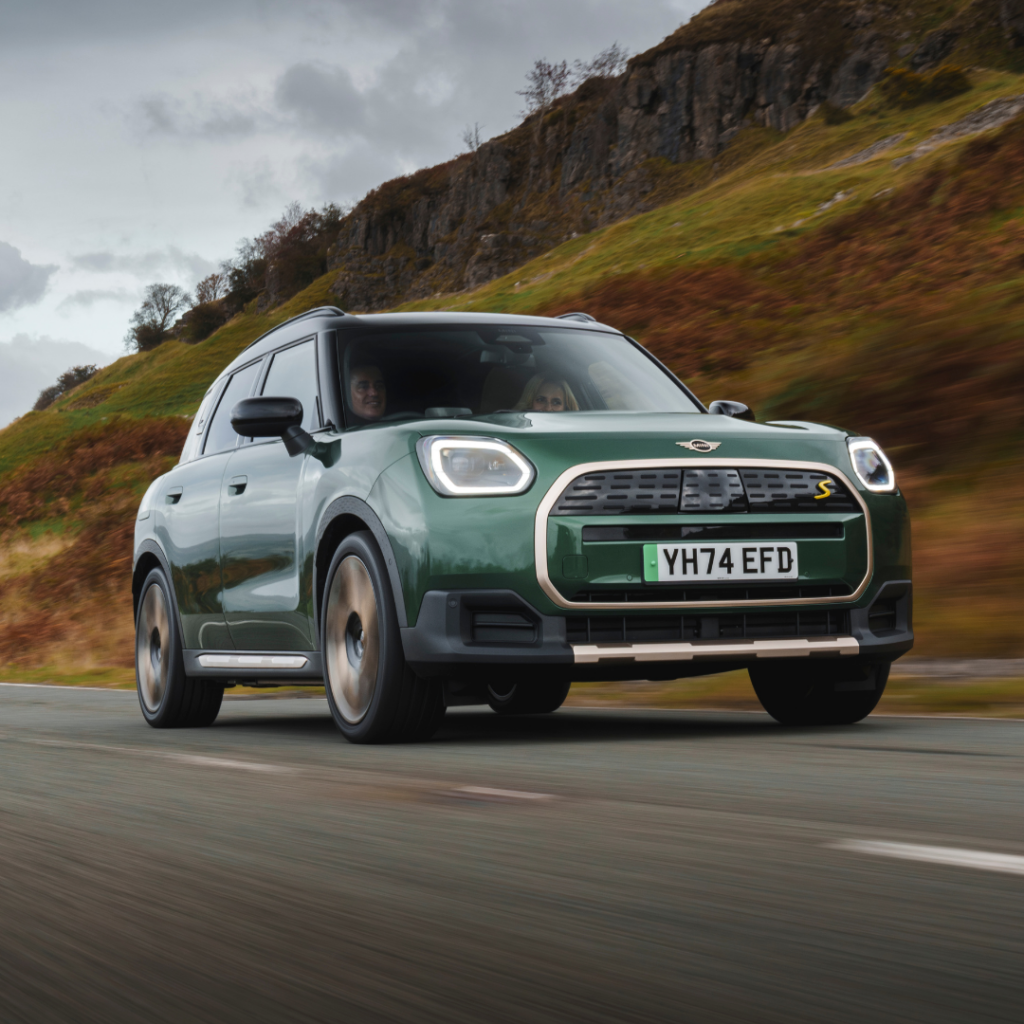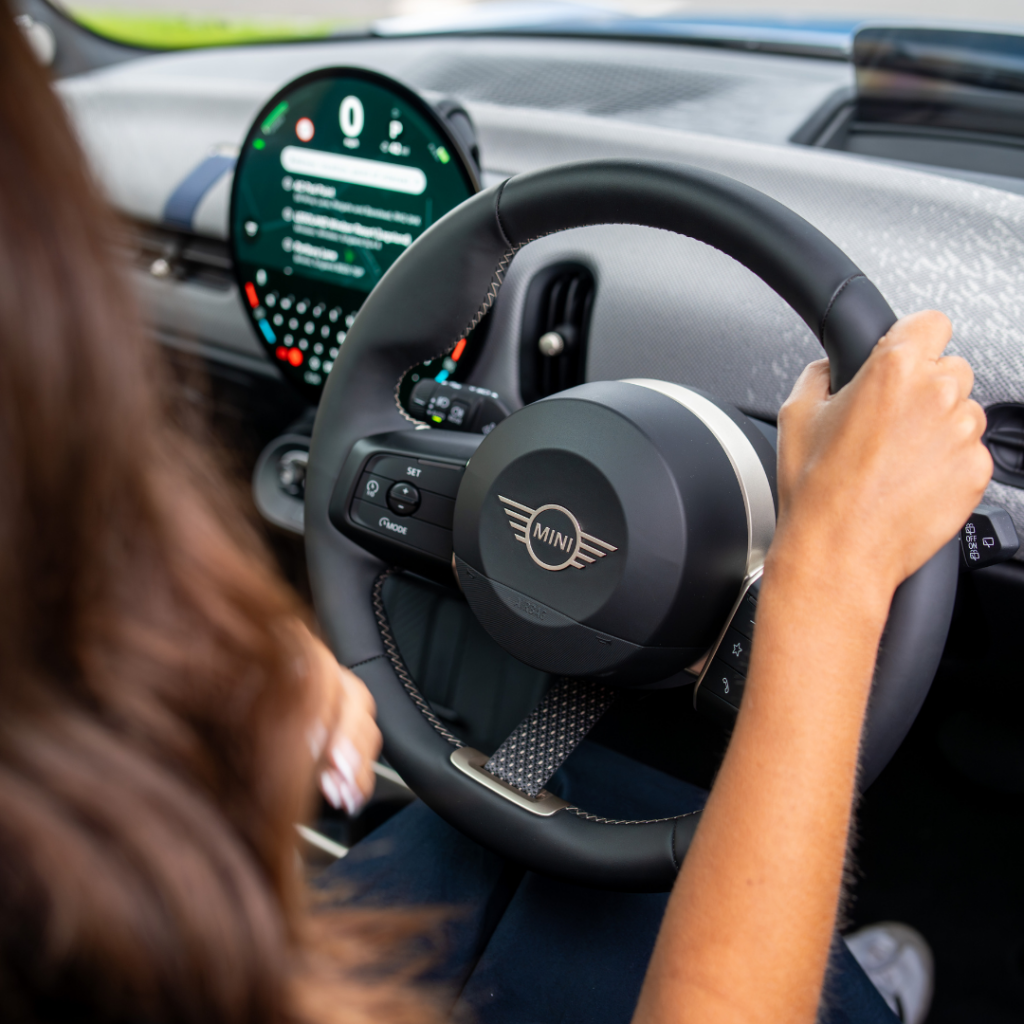
GOING ELECTRIC.
There’s never been a better time to make the switch to electric. To make a change for the better. In a MINI that’s more positive and more fun than ever before. Wondering what the electric life might look like? Let us take you through it.
START THE DAY FULLY CHARGED.
Whether at home or on the go, you’ll find charging up to be a total cinch. Discover the hundreds of places you can do it, from your driveway to the supermarket and even shopping centres.
- Most electric charges happen at home, and can be done between drives and overnight with total ease. Click here to explore home charging options.
- Charging your MINI in public couldn’t be easier. You can find over 39,000 charge points at over 14,000 EV charge stations in the UK. An increasing number of public spaces, such as shopping centres and supermarkets, often offer free use of their charging facilities. Click here to explore public charging options.
As the demand for electric cars and charging facilities is growing, then workplace charging is certainly worth considering. Many employers have now embraced electric mobility and offer a more modern workspace by providing EV charging stations for their employees.
If your employer hasn’t implemented workplace charging yet, and there is space, why not suggest that workplace charging could be a good move. There may be grants, rebates and other incentives available for your company to fund your program and charging infrastructure. Click here to discover the workplace charging grants.

START THE DAY FULLY CHARGED.
It pays to drive electric with MINI. Enjoy the many ways you can save money when you make the switch, thanks to low running costs, simpler servicing and government grants.
- At just 7p a mile*, MINI Electric costs a lot less to run than petrol or diesel cars. And with it being around three quarters cheaper, it means you can travel more and spend less. On top of reduced running costs, there’s also a host of tax savings and grants to enjoy. Click here to see what you could save.
- Electric motors, like the one found inside MINI Electric, are less complex than their combustion counterparts. Because there are fewer moving parts, it means there’s less wear and tear. So maintenance can be kept to a minimum. When it’s time for a service, we can help you keep costs down with our simple pay monthly plans. Click here to explore MINI Electric Vehicle Servicing.

SEE HOW MUCH YOU COULD SAVE.
By switching to electric you can enjoy saving on fuel, road tax and congestion fees. Work out how much you could save with our online calculator. Simply enter postcodes of a typical journey and we’ll figure out the rest. Click here to see how much you could save.

meet the electric family.
frequently asked question about electric cars.
HOW DO I FIND CHARGING POINTS?
MINI Navigation can help you find your nearest charging point, and take you right to it. The system is loaded with every charging point in our network.
You can also search for charging stations. Set "charging stations" as a special destination in the navigation system, and a list of stations nearby will appear on screen.
Take things one step further with the MINI Charging app. It gives you to access to a list of all available charging stations via your smartphone.
HOW DO CHARGING STATIONS WORK?
You can use the MINI Charging map or the MINI Charging app to unlock charging stations and start the charging process.
Some charging columns can be operated using the MINI Charging app. The app, which features an integrated QR code scanner, is as easy to use as it is to install. To do so, simply download the app, enter your MINI Charging contract number and your PIN.
HOW DO I PAY?
You’ll pay for to charge back up with cashless payments. You can choose to pay conveniently via a monthly direct debit from your payment account. Check in to your MINI Charging online account for an up-to-date snapshot of your costs and charging behaviour.
WHAT DO I NEED TO KNOW WHAT CHARGING?
1. If necessary, set the current before charging.
2. Do not use any extension cables.
3. Always connect and disconnect the charging cable in this order:
Connecting:
1. Connect to the socket.
2. Connect to the vehicle.
Disconnecting:
1. Disconnect from the vehicle.
2. Disconnect from the socket.
LED lights:
1. White light: Signal light
2. Red light: Charging error
3. Orange light: Initialising
4. Blue light: Charging active
5. Green light: Charging complete
4. Lock the vehicle. The charging process will only start once your vehicle is locked.
IS THERE A DIFFERENCE BETWEEN CHARGING USING ALTERNATIVE CHARGING (AC) AND DIRECT CURRENT (DC)?
Normal charging with alternating current (AC):
Choose AC to charge your car efficiently. Primarily to be used overnight but can also be selected during the day. Compared to a domestic power socket, an AC charging station provides more power and can charge the battery in just a few hours.
Quick charging with direct current (DC**):
DC** quick charging stations are the best option if you want to charge your car fast. They can recharge your vehicle's battery quickly in just 30-40 minutes. Perfect timing if you’re about and about shopping or having a bite to eat.
WHO DO I CONTACT FOR HELP IF I HAVE PROBLEMS WITH THE CHARGING COLUMN?
If you encounter a problem with the charging column, please contact the operator of the charging column. Their contact number can usually be found on the charging column.
WHAT ARE THE KEY RAW MATERIALS USED WITHIN HIGH-VOLTAGE AND WHY DO YOU NEED TO ENSURE THEY ARE SOURCED RESPONSIBILY?
The key raw materials of the high-voltage storage are cobalt, lithium, graphite and nickel. The shell of the high-voltage battery is made of aluminum. MINI is committed to developing a supply chain that is responsible, sustainable and meets our own high ethical and human rights standards. Each nominated supplier must provide information on the implementation of environmental, social and governance standards including respect for human rights and the prohibition of forced labour. We work closely with key raw material suppliers to ensure that all materials are responsibly sourced both to protect and enhance the environment, and to ensure the safety and well-being of the employees at any point along the supply chain. We also continue to streamline logistics operations to reduce impacts from transporting components to our plants.
DO YOU KNOW THE SOURCES OF THESE RAW MATERIALS AND HOW DO YOU ENSURE YOUR SUPPLIER MEETS THE SUSTAINABILTY REQUIREMENTS?
MINI examines the origin of our raw materials closely. When selecting suppliers, we adhere to the OECD Due Diligence Guidance for Responsible Business Conduct. In addition to that, we commit our direct suppliers to meet our sustainability requirements with their own suppliers. The transparency of supplier networks is the basis for ensuring our sustainability requirements for our suppliers.
HOW DO YOU ENSURE THAT COBALT IS RESPONSIBLY SOURCED?
Together with BASF, Samsung SDI and Samsung Electronics, we are committed to sustainable cobalt mining. In a joint project in the Democratic Republic of the Congo, we want to understand how the living and working conditions of local people can be improved. In order to prevent or mitigate adverse impacts and not to let the people of the Congo down, we have also commissioned the German Society for International Cooperation (GIZ) GmbH to improve working conditions in artisanal cobalt mining in a pilot project in the DR Congo.
We are aware of our responsibility that the raw materials are mined and processed under normal conditions. We are regularly on-site, know the mines and the working methods of our partners and ensure a clean recovery.
In addition to this, to generally limit the need for critical raw materials such as cobalt, the BMW Group, which MINI is part of, pursues the goal of increasing the proportion of recycled cobalt in battery cells.
WHAT STEPS DO YOU TAKE TO ENSURE THE PROCUREMENT PROCESS FOR ALUMINIUM IS FAIR AND SUSTAINABLE?
In the aluminium procurement process, we not only buy for our own needs, but also make this material available to our suppliers, reliably and at calculable prices.
This creates greater planning security on both sides. In order to be able to meet our long-term demands for sustainably produced aluminium in the future, the BMW Group became the first automobile manufacturer to join the Aluminium Stewardship Initiative – actively demanding ecological and social sustainability for certified aluminium across the entire aluminium value chain – from the mine to the recycling process.
We also strive to source more recycled aluminium in our manufacturing processes. The use of secondary materials has a positive effect, especially on the following aspects of sustainability: biodiversity, CO2 emissions (especially in raw materials with energy-intensive production such as aluminium, steel and copper) and the reduction of waste. The average share of secondary aluminium in our vehicles is 20%. For aluminium casting alloys, it is 40%. We work with the Aluminium Stewardship Initiative on the certification of our aluminium partners in accordance with the outlined sustainability standard. For more information please visit aluminium-stewardship.org
WHERE DOES THE LITHIUM COME FROM AND HOW TO YOU MAINTAIN A SUSTAINABLE SOURCING PROCESS?
AT WHAT POINT DOES THE MINI ELECTRIC BECOME GREENER THAN THE MINI COOPER S?
The greenness of any electric car ultimately depends on the source of the mains electricity that feeds the battery.
Another aspect of the lifetime CO2 footprint is the energy used to manufacture the battery pack. With this in mind, tests showed that if the MINI Electric is charged using a renewable electricity mix, it breaks even or has ‘worked off’ the CO2 released during its manufacturing after approximately 19,000 km.
Over a full life cycle, the emissions of a MINI Electric are 40% (EU mix) and 70% (renewable mix) compared to that of a petrol-driven MINI Cooper S. That means, using typical daily driving distances, it takes just twelve months of driving for the MINI Electric to offset the extra global warming emissions from producing it.

